Full Length Research Paper
ABSTRACT
This work aimed to evaluate dry matter intake (DMI) and performance of F1 Nellore x Guzera with live weight (LW) of 180±15 kg (5 months) on pastures of Brachiaria brizantha cv. Marandu in silvo-pastoral systems composed of babassu palm (Attalea speciosa) and monoculture systems in Pre-Amazonic region of Maranhão state, Brazil. Animals were evaluated in four systems: 0, 80, 131 and 160 adult palms ha-1, characterizing monoculture (MC), low density (LD), average density (AD) and high density palm trees (HD), respectively, during the rainy (RS) and dry season (DS). Comparing seasons, only DMI in MC and AD were affected. DMI was between 2.6% LW for the RS and 2.8% LW for the DS, These values are very close as suggested by NRC, which is 2.7% LW for animals in this category. Higher average daily gain per ha was observed in animals kept in pastures with LD (0.750 g.day-1 and 84.37 kg.ha-1, respectively). It was observed that animal performance was influenced by density of palm trees and the DMI by season, probably by the sward structure. Animal performance and production forage biomass were higher in 0 and 80 palm systems. This greater forage biomass allow higher stocking rate and, consequently higher animal production per ha.
Key words: Silvo-pastoral systems, pasture, season, Guzerá, Nelore, matter intake, daily gain.
INTRODUCTION
MATERIALS AND METHODS
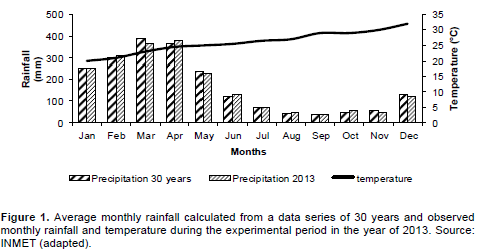
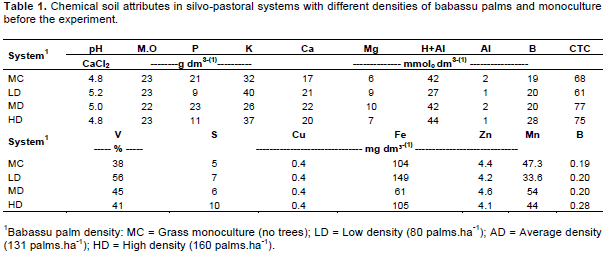
RESULTS AND DISCUSSION
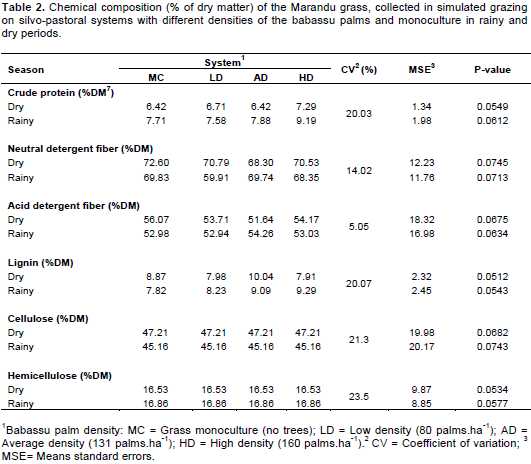
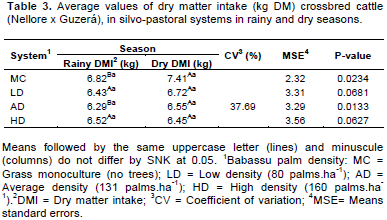
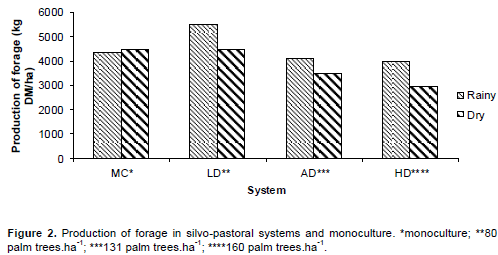
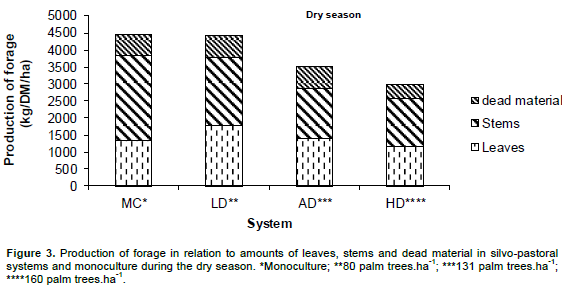
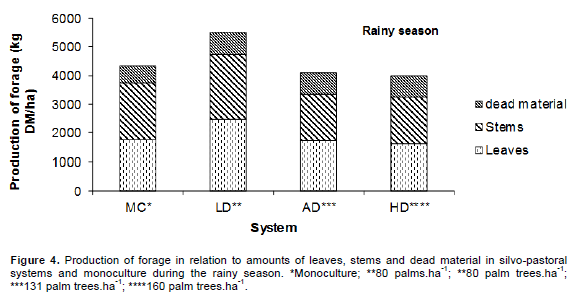
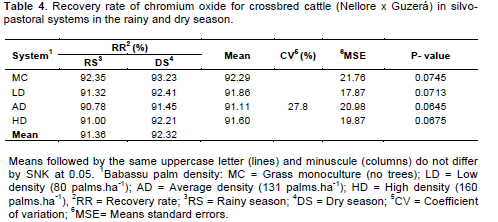
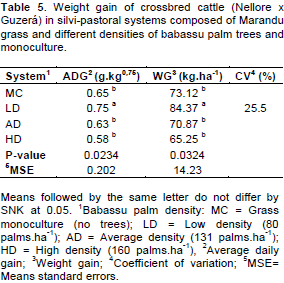
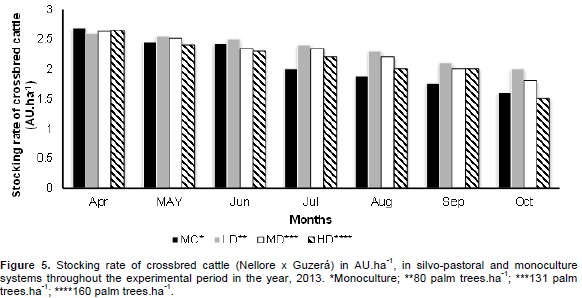
CONCLUSIONS
CONFLICT OF INTERESTS
REFERENCES
|
Aroeira LJM, Paciullo DSC, Lopes FCF, Morenz MJF, Saliba ES, Silva JJ, Ducatti C (2005). Herbage availability, chemical composition and dry matter intake in mixed pasture of Brachiaria decumbens with Stylosanthes guianensis. Braz. Agric. Res. 40(4):413 418. |
|
|
AOAC (1990). Association of Official Analytical Chemists. Official methods of analysis. 15th edn, Arlington, Virginia. |
|
|
Bernardino FS, Tonucci RG, Garcia R, Neves JCL, Rocha GC (2011). Forage yield and performance of beef steers in a silvopastoral system: effects of forage offers and nitrogen fertilization. Braz. J. Anim. Sci. 40(7):1412-1419. |
|
|
Berchielli TT, Oliveira SG, Carrilho ENVM, Feitosa JV, Lopes AD (2005). Comparison of markers used to estimate fecal production and digesta flow of cattle. Braz. J. Anim. Sci. 34(3):987-996. |
|
|
Da Silva AC, Firmo D (2008). The studies of "braquiarão" grass (Brachiaria brizantha) effects on babassu palm tree (Orbygnia spp.) initial development stage. Green J. 3(4):1-7. |
|
|
Detmann E, Paulino MF, Zervoudakis JT, Valadares Filho SC, Euclydes RF, Lana RP, Queiroz DS (2001). Chromium and Internal markers in intake determination by crossbred steers, Supplemented at Pasture. Braz. J. Anim. Sci. 30(5):1600-1609. |
|
|
Gomide JÁ, Wendling IJ, Bras SP, Quadros HB (2001). Milk Production and Herbage Intake of Crossbred Holstein x Zebu Cows Grazing a Brachiaria decumbens Pasture under two Daily Forage Allowances. Braz. J. Anim. Sci. 30(4):1194-1199. |
|
|
Malafaia P, Peixoto PV, Gonçalves JCS, Moreira AL, Costa DPBD, Correa WS (2004). Daily weight gain and costs of beef cattle receiving two types of mineral supplements. Pesqui. Vet. Bras. 24(3):160-164. |
|
|
Moreira GR, Saliba EOS, Maurício RM, Sousa LF, Figueiredo MP, Gonçalves LC, Rodriguez NM (2009). Evaluation of Brachiaria brizantha cv. Marandu in silvopastoral systems. Braz. Arch. Vet. Med. Anim. Sci. 61(3):706-713. |
|
|
Moura EG (2004). Agroambientes transition evaluated from the point of view of family agriculture between the Amazon and the Northeast, diversity and structure (2004). In: Agroambientes of transition between the topic humid and semi-arid regions of Brazil: attributes, changes, use in household production. (Edit: São Luís: UEMA). pp. 15-51. |
|
|
Oliveira TK, Macedo RLG, Santos IPA, Higashikawa EM, Venturin N (2007). Productivity of Brachiaria brizantha (Hochst. ex A. Rich.) Stapf cv. Marandu under different spacings on agrosylvopastoral system with eucalypt. Sci. Agritechnol. 31(3):748-757. |
|
|
Paciullo DSC, Campos NR, Gomide CAM, Castro CRT, Tavela RC, Rossiello ROP (2008). Growth of signalgrass influenced by shading levels and season of the year. Braz. Agric. Res. 43(7):917 923. |
|
|
Paciullo DSC, Carvalho CAB, Aroeira LJM, Morenz, MJF, Lopes FCF, Rossiello ROP (2007). Morphophysiology and nutritive value of signalgrass under natural shading and full sunlight. Braz. Agric. Res. 42(4):573-579. |
|
|
SAS (2002). Statistical Analysis System Institute, Institute. SAS user's guide: statistics. 5, ed. Cary: SAS. |
|
|
Silva DJ, Queiroz AC (2009). Food Analysis: chemical and biological. 3rd edition, 4th reprint. 235 p. |
|
|
Soares JPG, Berchielli TT, Aroeira LJM, Deresz F, Verneque RS (2004). Chromium Oxide technique for entake estimates of chopped Elephantgrass (Pennisetum Purpureum Schum.) using lactating cows. Braz. J. Anim. Sci. 33(3):811-820. |
|
|
Tilley JMA, Terry RA (1963). A two stages technique for the "in vitro" digestion of forage crops. J. Brit. Grassl. Soc. 18(2):104-111. |
|
|
Van Soest PJ (1994). Nutritional ecology of the ruminant. 2 ed. Ithaca: Cornell University Press. P 476. |
|
|
Williams CH, David DJ, Iismaa O (1962). The determination of chromic oxide in faeces samples by atomic Absorption spectrophotometry. J. Agric. Sci. 59(3):381-385. |
|
Copyright © 2024 Author(s) retain the copyright of this article.
This article is published under the terms of the Creative Commons Attribution License 4.0